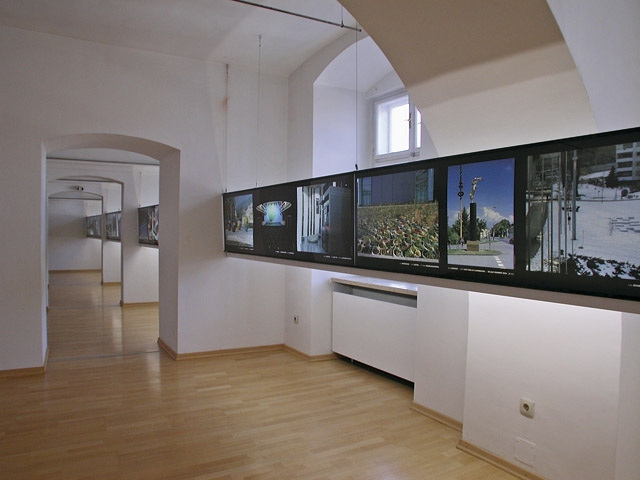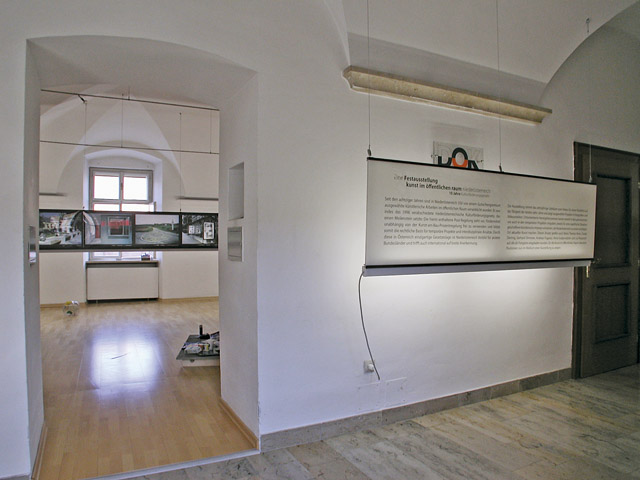A Jubilee Exhibition: Public Art in Lower Austria — 10 Years of the Law for the Promotion of Culture
1 to 30 September 2006
St. Pölten, NÖ Dokumentationszentrum für moderne Kunst
The exhibition was organised to mark a decade since the passing of the law for the promotion of culture in Lower Austria, which cannot be praised highly enough as a political policy decision and signifies a basic improvement of working opportunities in the region. Accordingly, the exhibition was truly a celebration of the jubilee, the explicit aim of which was to provide a comprehensive presentation of the extensive programme in federal state. At the time 350 projects had been realised, of which 100 were selected for a band of photographs running through the space. The chronologically arranged photographs by famous photographers, like Margherita Spiluttini or Christian Wachter, provided a representative insight and was also planned to go on tour by the exhibition's architect Walter Kirpicsenko. The photographs were supplemented by specially made videos and documentary video footage as well as documentation and archive material. Volume 8 of Public Art Lower Austria was presented at the opening of the exhibition, during which the compilation of a complete bound index covered all of the activities of the Public Art Department in alphabetical listings of the artists, venues and locations concerned while also serving as documentation of the exhibition itself.
In addition to presenting the Public Art programme, six artists who specialised in exemplary progressive use of the exhibition as a medium, and of particular relevance to current practise in Lower Austria, (Maria Thereza Alves, Carola Dertnig, Gerhard Dirmoser, Andreas Fogarasi, Anna Gudjonsdottir and Lia Perjovschi) were invited to contrast selected works of their own with art produced in the region. Just as programmes for art in public space are frequently tied to towns and cities, in Lower Austria the locations are smaller towns, villages and open countryside. Often the issues confronting the art are very specific here, and the art is required to address larger concepts of space, site-specifity and history, as well as the challenges of communication and participation.
1 to 30 September 2006
St. Pölten, NÖ Dokumentationszentrum für moderne Kunst
The exhibition was organised to mark a decade since the passing of the law for the promotion of culture in Lower Austria, which cannot be praised highly enough as a political policy decision and signifies a basic improvement of working opportunities in the region. Accordingly, the exhibition was truly a celebration of the jubilee, the explicit aim of which was to provide a comprehensive presentation of the extensive programme in federal state. At the time 350 projects had been realised, of which 100 were selected for a band of photographs running through the space. The chronologically arranged photographs by famous photographers, like Margherita Spiluttini or Christian Wachter, provided a representative insight and was also planned to go on tour by the exhibition's architect Walter Kirpicsenko. The photographs were supplemented by specially made videos and documentary video footage as well as documentation and archive material. Volume 8 of Public Art Lower Austria was presented at the opening of the exhibition, during which the compilation of a complete bound index covered all of the activities of the Public Art Department in alphabetical listings of the artists, venues and locations concerned while also serving as documentation of the exhibition itself.
In addition to presenting the Public Art programme, six artists who specialised in exemplary progressive use of the exhibition as a medium, and of particular relevance to current practise in Lower Austria, (Maria Thereza Alves, Carola Dertnig, Gerhard Dirmoser, Andreas Fogarasi, Anna Gudjonsdottir and Lia Perjovschi) were invited to contrast selected works of their own with art produced in the region. Just as programmes for art in public space are frequently tied to towns and cities, in Lower Austria the locations are smaller towns, villages and open countryside. Often the issues confronting the art are very specific here, and the art is required to address larger concepts of space, site-specifity and history, as well as the challenges of communication and participation.



